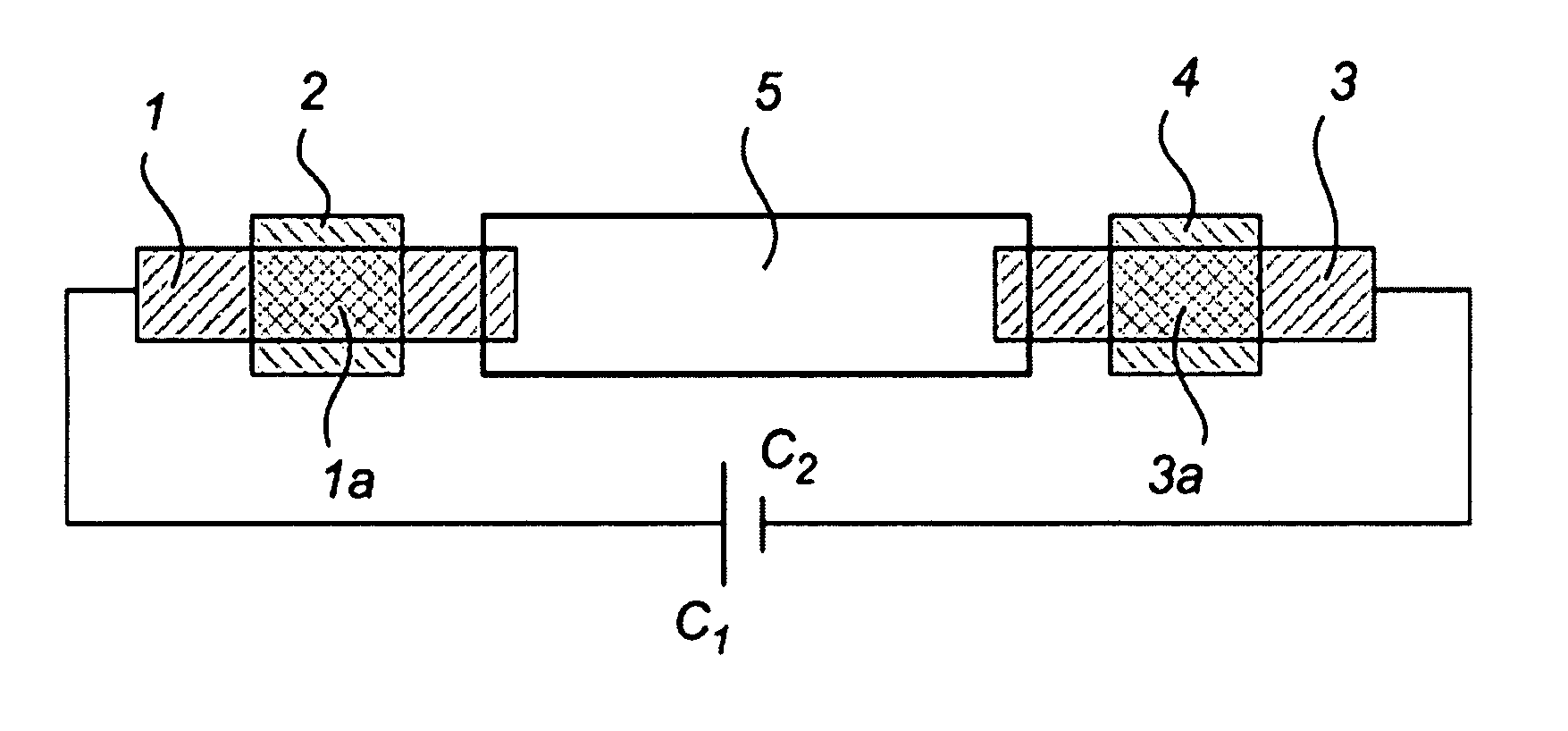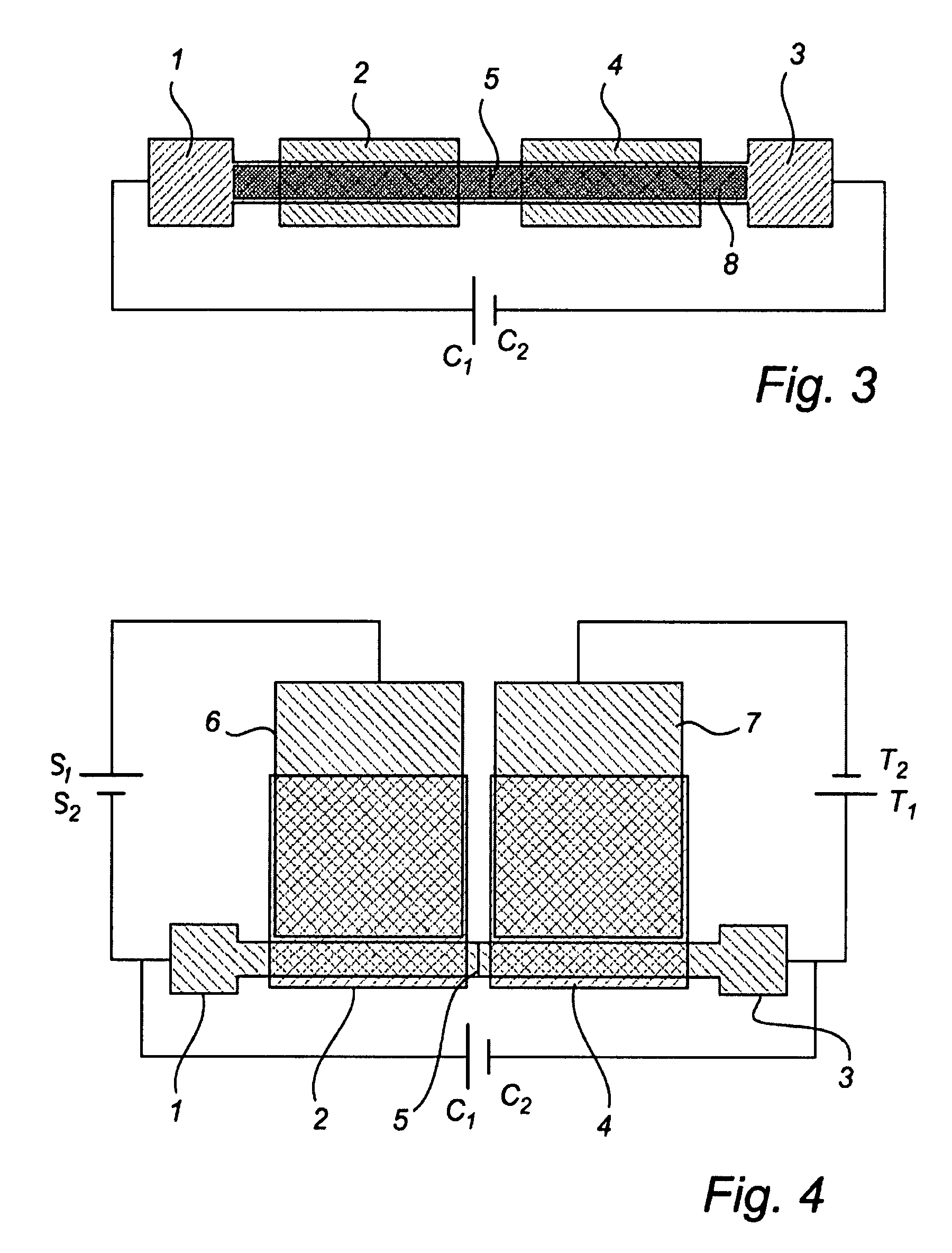Electrically controlled ion transport device
a technology of electric control and ion transport, which is applied in the direction of filtration separation, lavatory sanitory, light and heating apparatus, etc., can solve the problems of unspecific delivery of ions, inability of available methods to provide controlled ion flux to cells, and little is known about the molecular and physiological effects of cells, etc., to achieve high volume production and low cost
- Summary
- Abstract
- Description
- Claims
- Application Information
AI Technical Summary
Benefits of technology
Problems solved by technology
Method used
Image
Examples
embodiment 1
[0145]A schematic top-view of an ion transport device according to the invention is shown in FIG. 1. According to this embodiment device comprises a source electrode 1 and a target electrode 3, each capable of conducting ions and electrons. Said electrodes 1,3 have an elongated shape, are preferably arranged as layers and at a distance from each other, i.e. are not in direct physical contact with each other. A portion 1a of the source electrode 1 is in ionic contact with a portion of a source electrolyte 2, and a portion 3a of the target electrode 3 is in ionic contact with the target electrolyte 4. In other words, ions can be transported from said source electrolyte into said source electrode, and transported from said target electrode to said target electrolyte, respectively, by means of diffusion. According to one embodiment of the invention said electrolytes 2,4 are in direct physical contact with the respective electrode 1,3, and according to another embodiment a material capab...
embodiment 2
[0149]A second embodiment of the invention is schematically illustrated in FIG. 2. This embodiment is arranged as described in relation to FIG. 1, except that the source electrode 1, target electrode 3 and ion conductive channel 5 is made of a unitary piece of electrically conductive polymer material, wherein the ion-conductive channel 5 has been formed by rendering a portion of the polymer material electrically non-conducting, or at least essentially non-conducting by means of e.g. overoxidation, which portion is arranged between said source electrode 1 and said target electrode 3. In FIG. 2 the ion-conductive channel is illustrated as a thin line, but the length of the ion-conductive channel, as taken from said source electrode to said target electrode, can also be substantially longer.
embodiment 3
[0150]A third embodiment of the invention is schematically illustrated in FIG. 3. This embodiment is arranged as described in relation to FIG. 1 or 2, except that the ion conductive channel 5, the source electrode 1 and the target electrode 3 further comprises layer of a polymer hydrogel 8, which is arranged between the electrically conductive materials of the electrodes and a respective portion of the source and target electrolytes, such that in ionic contact between the source and target electrolyte and said respective portion of the polymer hydrogel is provided. The hydrogel layer increases ion transport from the first to the second electrolyte by providing an easily accessible pathway for ion transport.
PUM
| Property | Measurement | Unit |
|---|---|---|
| thickness | aaaaa | aaaaa |
| voltage | aaaaa | aaaaa |
| voltage | aaaaa | aaaaa |
Abstract
Description
Claims
Application Information
 Login to View More
Login to View More - R&D
- Intellectual Property
- Life Sciences
- Materials
- Tech Scout
- Unparalleled Data Quality
- Higher Quality Content
- 60% Fewer Hallucinations
Browse by: Latest US Patents, China's latest patents, Technical Efficacy Thesaurus, Application Domain, Technology Topic, Popular Technical Reports.
© 2025 PatSnap. All rights reserved.Legal|Privacy policy|Modern Slavery Act Transparency Statement|Sitemap|About US| Contact US: help@patsnap.com



